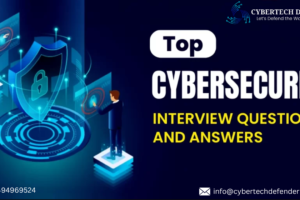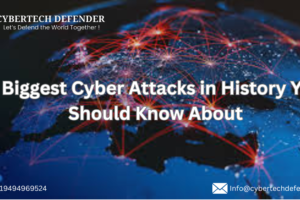
Top 5 Cybersecurity Trends You Can’t Ignore
Did you know that more than 800,000 people are victims of cyberattacks every year?
The question is, with such advancement in technology, why is our cybersecurity infrastructure not able to withstand these attacks?
It’s because the hackers keep changing the way they attack our systems.
Safe to say, they are one step ahead of us.
So what’s the solution?
We need to stay updated on the latest cybersecurity trends. That will not only help us understand how hackers can attack our systems but will also enable us to prepare for it.
That’s what we are doing in this blog.
We will discuss the top cybersecurity trends that everyone should be aware of. We will understand the threats surrounding our online security and how we can overcome them
5 Cybersecurity Trends You Should Know

Top 5 Cybersecurity Trends You Should Know
- Remote Work Security
- Artificial Intelligence & Machine Learning
- Quantum Computing
- Internet of Things (IoT)
- Cybersecurity Skill Gap
These are the 5 top cybersecurity trends you should know if you are deciding to either upskill yourself or your team to counter cybersecurity challenges.
1. Expansion of Remote Work
How to Prevent the Vulnerabilities of Systems in Remote Work
There are a few ways organizations can prevent this
- To prevent such incidents, companies must implement robust remote access solutions like Virtual Private Network (VPN) and secure remote desktop protocols.
- Another thing companies can do is provide cybersecurity training to employees. This will prepare them to identify and respond to potential online threats.
- Many organizations offer brilliant information security courses and vulnerability management courses. Companies can enroll their cybersecurity team in these courses to equip them with world-class knowledge.This way companies can create a strong cyber security culture and protect their sensitive data and systems.
2. Artificial Intelligence & Machine Learning (AI/ML)
Until a few years ago, artificial intelligence seemed like something that belonged only in science fiction movies. But it is very much a reality now.
Although it has transformed every field, its contribution to cybersecurity is unprecedented. It allows automation, accuracy, and speed in threat detection, response, and prevention at levels that weren’t possible before.
How Artificial Intelligence Helps with Cybersecurity
Here are a few ways in which AI/ML helps:
- AI-powered systems can detect and handle threats in real time, thus, reducing the containment period of an attack. Not only that, ML algorithms can also learn from previous events. That helps them become more capable of recognizing and stopping new attacks.
- For example, AI can examine network traffic patterns to find abnormal behaviors that might suggest malicious activities and automatically block suspicious connections.
- AI/ML plays a critical role in improving threat intelligence capabilities. Security teams can get important knowledge about adversary tactics, techniques, and procedures (TTPs) through analysis of different sources of threat data. This information can then be used for better prevention and detection methods.
However, we must remember that AI/ML are not magical solutions. Hackers can also employ these technologies to make their attacks more sophisticated.
Hence, there is a need for a comprehensive cybersecurity approach that integrates human skills with AI/ML to achieve maximum security levels
3. Quantum Computing
While AI/ML is now a reality, quantum computing is still in the theoretical stages. But its applications have a much wider scope.
From artificial intelligence to drug development, quantum computing can facilitate advancement in almost all fields with the speed of light. But with every positive milestone of technology comes something negative attached to it.
With quantum computing, hackers can easily break traditional encryptions. This poses a significant threat to the confidentiality, integrity, and availability of data.
Last year, Microsoft warned companies against potential quantum cyber threats. It advised them to prepare for such attacks and has also started an initiative to understand how prepared they are for these attacks.
How Experts are Countering the Threat of Quantum Computing
The industry is exploring quantum-resistant cryptographic solutions to counter this threat. These algorithms will be designed to endure the computational power of quantum computers. That will make our digital infrastructure more powerful and resilient.
Researchers are also trying to find ways to use quantum computing to enhance cybersecurity. They are developing new methods of detecting and responding to cyberattacks
4. Internet of Things (IoT)
IoT is a gift we didn’t know we needed until we used it and realized we can’t live without it. The interconnectedness it offers to humans and machines has changed the way we look at the world.
According to Exploding Topics, there are approximately 17.08 billion connected devices. This shows the widespread popularity and adoption of IoT devices.
However, this interconnectedness that brings many benefits also attracts complex and expanding attacks. IoT devices often focus on functionality rather than security which makes them an easy target for hackers.
According to Statista, there were 112 million cyber attacks on IoT devices in 2022.
The number and variety of IoT devices only make their weaknesses more serious. With so many devices and systems in place, it becomes difficult to implement consistent security measures.
Moreover, the development of robust security standards is not able to match the rapid pace of IoT innovation. That presents new opportunities for hackers to exploit vulnerabilities in the system.
How to Overcome Cyber Security Challenge in IoT
To counter this challenge, we require different approaches:
- Manufacturers should focus on security by designing it into devices at the manufacturing stage itself. That means using solid encryption methods wherever necessary, strong authentication protocols, and updating software regularly.
- Organizations deploying IoT devices should conduct thorough risk assessments, implement access controls, and monitor their IoT environments for signs of compromise.
- There should be a collaboration between device manufacturers, policymakers, and cybersecurity experts to develop strict and comprehensive IoT frameworks.
5. Cybersecurity Skill Gap
This is one of the most challenging cybersecurity trends that we need to address quickly if we want to create a safe digital world.
- According to the World Economic Forum, there is a shortage of 4 million cybersecurity workers in the world.
- According to CyberSeek, 466,000 cybersecurity workers are required in the US.
- According to the WEF Cybersecurity Head, there is a shortage of 8 lakh cybersecurity professionals in India.
This shortage is making it challenging to find and retain qualified professionals.
How to Overcome the Cybersecurity Skill Gap Challenge
There are a few ways to overcome this challenge:
- Investing in cybersecurity education and training programs is crucial to developing a robust talent pipeline. By providing opportunities for individuals to acquire the necessary skills and certifications, organizations can help bridge the skills gap and build a skilled cybersecurity workforce.
- Promoting public-private partnerships can help share knowledge among industry, academia, and government while also fostering collaboration. Working collectively will enable stakeholders to come up with new ways of tackling the shortage in cyber-security skills.
- For their current cybersecurity teams, enterprises need to give learning a priority. When organizations offer ways through which their teams can improve their skills, they will always be prepared for any emerging cybersecurity dangers.
Stay Relevant with the Latest Cybersecurity Trends with CyberTech Defender
The only way to gain the most relevant cybersecurity skills for yourself or your team is through constant learning.
For that, you need someone who knows this field so well that their courses are relevant for modern times.
In this, CyberTech Defender is your best bet!
Our expert teachers are up-to-date with cybersecurity trends and what the industry expects from its workers.
Our courses provide theoretical as well as practical teachings. We focus on real-world scenarios, hands-on experience, and real-time use cases.
If you are ready to invest in the safety of your and your organization’s digital future, contact us. We will understand your needs to guide you in the best way possible.
Together, we will build a digitally safer world!



